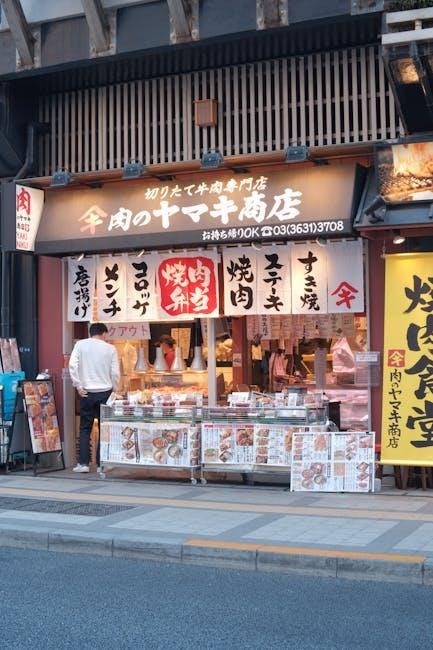Executive Order 9066, issued in 1942, forcibly relocated Japanese Americans to internment camps, uprooting lives and communities during World War II.
Background on Executive Order 9066
Executive Order 9066, issued by President Franklin D. Roosevelt on February 19, 1942, authorized the forced relocation of Japanese Americans to internment camps. This action, driven by fear of espionage and national security concerns after Pearl Harbor, led to the displacement of over 120,000 individuals, most of whom were U.S. citizens. The order granted military commanders the authority to designate areas from which individuals of Japanese ancestry were excluded, resulting in the violation of constitutional rights and the upheaval of countless lives.
Historical Context: The Impact of Pearl Harbor
The attack on Pearl Harbor on December 7, 1941, intensified anti-Japanese sentiment in the U.S., fueling fears of sabotage and espionage. This event directly led to Executive Order 9066, as the government deemed Japanese Americans a potential threat. The emotional and political fallout from the attack created an environment where such drastic measures were justified, despite lacking evidence of widespread disloyalty. Pearl Harbor became a catalyst for the mass internment, overshadowing the constitutional rights of Japanese Americans and shaping a dark chapter in U.S. history.

Background and Context
Executive Order 9066, issued on February 19, 1942, by President Franklin D. Roosevelt, authorized the relocation of Japanese Americans, driven by wartime security concerns and underlying racial discrimination.
The Events Leading to the Issuance of Executive Order 9066
The attack on Pearl Harbor in 1941 intensified anti-Japanese sentiment in the U.S., fueled by fear of espionage and sabotage. Following the attack, the U.S. government and public viewed Japanese Americans with suspicion. This fear, combined with long-standing racial prejudices, created a political climate that justified drastic measures. On February 19, 1942, President Franklin D. Roosevelt signed Executive Order 9066, authorizing the forced relocation of Japanese Americans from the West Coast to internment camps. This decision was driven by wartime security concerns and widespread xenophobia, leading to the displacement of over 120,000 people.
The Role of Anti-Japanese Sentiment in the U.S.
Anti-Japanese sentiment in the U.S. surged after Pearl Harbor, fueled by fear, mistrust, and racial prejudice. Japanese Americans were viewed as potential threats, despite no evidence of espionage. This xenophobia, rooted in decades of anti-Asian discrimination, justified their forced relocation. The media and politicians exacerbated these fears, portraying Japanese Americans as disloyal. This climate of suspicion and hostility created public support for Executive Order 9066, leading to the internment of over 120,000 Japanese Americans, none of whom were ever convicted of espionage or sabotage.

Implementation of the Order
Executive Order 9066 led to the forced evacuation of Japanese Americans, who were ordered to sell their homes and businesses before being relocated to internment camps.
Evacuation Notices and Relocation Process
Evacuation notices were posted in Japanese-American communities, instructing families to prepare for relocation. Many were forced to sell their homes and belongings quickly, often at significant financial loss. The process was swift, with families given little time to comply. They were required to report to designated assembly centers, where they were tagged and escorted to remote internment camps. The uncertainty and chaos of the relocation caused immense emotional distress, as families were separated and livelihoods were destroyed. The process was deeply traumatic, marking the beginning of a painful chapter in their lives.
The Experience of Japanese Americans During Relocation
The relocation process was deeply traumatic for Japanese Americans, who were forced to abandon their homes and livelihoods with little notice. Families were given short deadlines to sell their belongings, often at significant loss. Once evacuated, they were taken to assembly centers before being transported to internment camps. The uncertainty and injustice of their situation caused profound emotional distress; Many faced harsh living conditions in the camps, with limited privacy and resources. The experience left lasting scars, as families struggled to rebuild their lives after the war, grappling with the loss of security and dignity.
Internment Camps
Internment camps were established in remote areas, holding over 120,000 Japanese Americans under harsh conditions with barbed-wire fences and armed guards, causing profound emotional trauma.
Living Conditions in the Camps
Living conditions in the camps were harsh and unsanitary, with overcrowded barracks, inadequate healthcare, and limited access to basic necessities. Families were often separated, and privacy was nonexistent. The camps, surrounded by barbed-wire fences, created a prison-like atmosphere, exacerbating feelings of confinement and hopelessness. Despite these challenges, internees attempted to maintain dignity by organizing community activities and adhering to routines, though the physical and emotional toll of their situation was immense.
Emotional and Psychological Impact on Internees
The forced relocation caused profound emotional trauma, with internees experiencing grief, anger, and a deep sense of betrayal. Many struggled with the loss of identity, dignity, and security, while the stigma of being labeled “enemy aliens” lingered long after the war. Families were fractured, and the mental health of internees suffered due to confinement and uncertainty. The trauma extended across generations, with survivors and their descendants grappling with anxiety, depression, and PTSD. Despite this, many internees showed remarkable resilience, finding strength in community and cultural traditions to cope with their ordeal.
Resistance and Opposition
Japanese Americans and allies actively resisted the unjust order, challenging its constitutionality and protesting the violation of civil liberties, sparking debates about justice and equality.
Legal Challenges to Executive Order 9066
The legality of Executive Order 9066 was contested in court, most notably in the Supreme Court case Korematsu v. United States. The Court upheld the order in 1944, ruling it a military necessity, though Justice Murphy dissented, calling it a “legalization of racism.” Decades later, in the 1980s, the Commission on Wartime Relocation and Internment of Civilians found that the order was not justified by security needs but by racial prejudice. This led to formal apologies and reparations for Japanese Americans, acknowledging the grave injustice of their internment.
Public and Political Opposition to the Internment
While many supported the internment, significant opposition emerged from civil rights groups, churches, and some politicians. Organizations like the ACLU and Quakers advocated for Japanese Americans’ rights, challenging the order’s constitutionality. Certain newspapers and public figures criticized the policy as unjust and un-American. Politicians, such as Senator Robert Taft, questioned its necessity. This opposition, though initially minority, played a crucial role in later redress efforts, highlighting the tension between national security concerns and civil liberties during wartime.

After the War
After the war, internment camps closed, and Japanese Americans returned home, rebuilding lives. The U.S. government later provided redress and reparations, formally apologizing for the injustice.
Redress and Reparations for Japanese Americans
In 1988, the U.S. government issued the Civil Liberties Act, providing $20,000 to each surviving Japanese American interned during WWII. This act acknowledged the grave injustice of their forced relocation and incarceration. The compensation was a formal apology and an attempt to heal the wounds inflicted by Executive Order 9066. Additionally, the government established educational programs to ensure such violations of civil liberties would never recur. These efforts aimed to restore dignity and recognize the enduring impact on affected families and communities.
The Long-Term Consequences of Internment
The internment of Japanese Americans caused lasting economic, emotional, and social harm. Many families lost homes, businesses, and savings, struggling to rebuild lives after the war. The trauma of incarceration led to mental health issues and a sense of betrayal among survivors. Trust in the government was shattered, affecting community cohesion and social standing. Intergenerational trauma persisted, impacting the lives of descendants. These consequences underscored the profound impact of Executive Order 9066 on Japanese American families and their place in American society for decades to come.

Legacy and Remembrance
Executive Order 9066 remains a powerful reminder of wartime injustice, with museums, memorials, and educational programs preserving the history to ensure such violations of civil liberties are never repeated.
Preserving the History of Japanese American Internment
Museums like the Japanese American National Museum feature exhibitions, such as “Instructions to All Persons,” showcasing original documents like Executive Order 9066. These exhibits highlight the forced relocation and internment experiences, preserving personal stories and historical artifacts. Memorials and educational programs further honor the legacy of internees, ensuring their history is not forgotten. Efforts to document survivor testimonies and create digital archives also play a crucial role in educating future generations about this significant chapter in American history and its impact on civil liberties. These initiatives aim to foster understanding and prevent similar injustices.
Commemoration and Education Today
Today, the history of Japanese American internment is commemorated through museums, educational programs, and annual events like the Day of Remembrance on February 19th. Organizations and exhibitions, such as those by the Japanese American National Museum, preserve personal stories and artifacts, fostering understanding of this unjust chapter in American history. Educational initiatives and digital archives ensure younger generations learn about the internment, emphasizing the importance of protecting civil liberties and preventing similar injustices. These efforts honor the resilience of Japanese Americans and promote a more inclusive society.
Executive Order 9066 remains a grave reminder of the violation of civil liberties during WWII, emphasizing the importance of safeguarding human rights and learning from past injustices.
Reflections on the Significance of Executive Order 9066
Executive Order 9066 stands as a stark reminder of the dangers of fear, prejudice, and unchecked executive power. It led to the unconstitutional incarceration of over 120,000 Japanese Americans, causing profound emotional and economic harm. The order violated basic civil liberties, highlighting the fragility of rights during wartime. Its legacy serves as a cautionary tale about the importance of protecting minority rights and upholding constitutional principles, even in times of crisis. It also underscores the resilience of Japanese Americans and the eventual recognition of past injustices through redress efforts.
Lessons Learned and Civil Liberties in Modern America
The internment of Japanese Americans under Executive Order 9066 serves as a grave reminder of the dangers of fear, prejudice, and government overreach. It highlights the importance of protecting civil liberties, especially during times of crisis. The lessons learned emphasize the need for vigilance in safeguarding constitutional rights and preventing the marginalization of minority groups. Today, these lessons remind Americans of the importance of justice, equality, and the ongoing fight against discrimination, ensuring that such injustices are never repeated.
